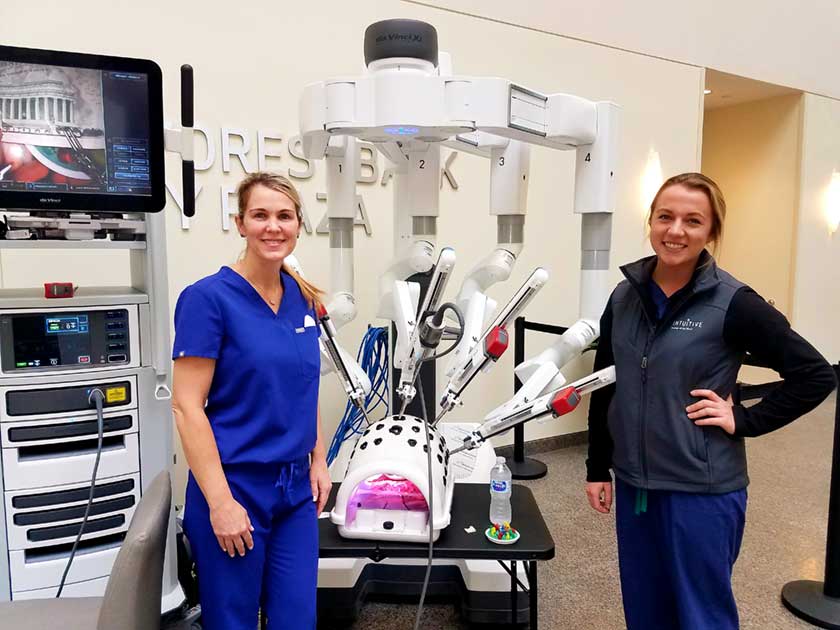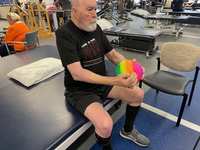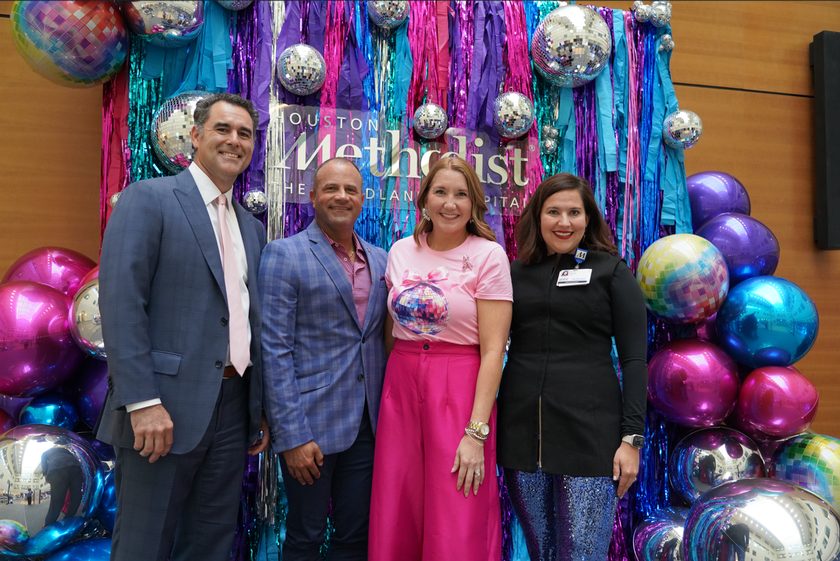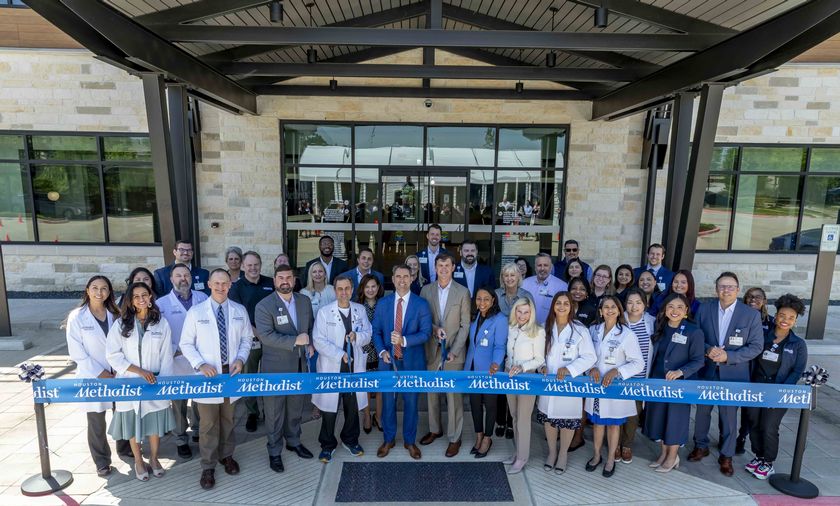- Sections :
- Crime & Public Safety
- Restaurants & Food
- Sports
- More
Categories
Cutting-edge healthcare technologies showcased at Houston Methodist The Woodlands Hospital

The WOODLANDS, Texas -- Houston Methodist The Woodlands showcased advanced, cutting-edge technologies now being utilized on Wednesday, Feb. 6. Patients and physicians alike benefit from the availability of these healthcare devices.
From the world’s smallest pacemaker to the da Vinci robotic surgery system, the hospital proudly featured innovations making a significant impact on health.
Debra Sukin, CEO of Houston Methodist The Woodlands, shared in the excitement of the latest offerings. Sukin said, “We are really excited because our whole vision and mission is really to be unparalleled in safety, quality, service and innovation. And when we talk about building a hospital, we have an opportunity to actually bring the latest and greatest in technology and be able to bring it as a tool for our great physicians.”
According to Sukin, Houston Methodist The Woodlands Hospital is bringing to the community “the types of technology that we believe aren't just nice and gimmicky ... but more importantly, really have an impact on the direct patient care piece, which is, of course, the most important thing that we do.”
Heart care has improved with devices such as the Micra transcatheter pacing system, the world’s smallest pacemaker. Micra TPS, from Medtronic, differs from the traditional pacemaker. This tiny device is placed into the heart via catheter, thus speeding up recovery times and decreasing post-surgery restrictions on mobility.
Apryl Stafford, with Medtronic, said with the use of endoscopic ultrasound technology doctors can “place a fiducial marker, or gold seeds, to mark to margins of the tumor ... The radiation oncologist can see exactly were(sic) that tumor is and then can apply the radiation directly to the tumor, and only that tumor, keeping all surrounding healthy organs safe from radiation.” Stafford said, “Houston Methodist The Woodlands is the only hospital up north that has the EUS technology to do this.”
Picture staying home from the doctor’s office while still receiving physician care for heart failure. According to Tyler Sheble, senior sales representative with Abbott/St. Jude, this is now possible. Sheble said, “This is a heart failure device that goes in the left pulmonary artery, and it helps physicians manage patient’s heart failure remotely from their house. So they don’t have to come in and get tested. They don’t have to phone in symptoms or anything like that. Physicians can actually take the data that this device gives through a monitor that can communicate with the physician's websites, and they can actually medicate a patient over the phone … It has been shown to reduce heart failure. It has been shown to reduce mortality.” Sheble said, “It is the only device of its kind.”
Higher definition color imaging goes beyond your television viewing experience from your couch. Siemens Healthineers developed CT scanning equipment putting better technology to use. Matthew Dedman, product marketing director with Siemens, said, “With this dual energy CT where we’re adding color and high def. to that image.” The result for physicians is the ability to much more easily identify an area of concern that may have been missed with past technologies.
“The Woodlands is really cutting edge. They’ve invested in a scanner from Siemens called the Somatom Force. It has a couple really unique technologies that really stand out from the rest of the CT scanners out there,” Dedman said. Commenting on the speed capabilities of the scanner, Dedman said, “We can scan a patient’s entire chest, abdomen and pelvis in less than a second … that’s really critical because imaging plays a key role in the emergency department.”
Lung cancer kills more people annually than breast, prostate, and colon cancer combined according to Caitlin Phelan, with Veran Medical Technologies. Phelan said, “Part of why we are at this hospital is they wanted to build a really competitive lung cancer screening program because right now in the community is a really, really big shortage of awareness.“ This serious condition calls for quick and accurate diagnosis so Houston Methodist has brought in Veran’s lung screening equipment. Phelan said, “We are a GPS for the lungs. So what we do is take a same day 3D picture of the patient’s lungs with a CT scan, and our software creates a 3D rendering of your anatomy ... The goal here is to get these lesions when they’re small because that changes the life expectancy exponentially.”
Surgery has taken three common forms: open surgery, laparoscopic surgery, and robotic surgery. Physicians maneuver their skilled hands easily in open surgery to get the job done. However, this has some major drawbacks including the size of the incision and recovery time. Laparoscopic surgery can be limited in the movements that are enabled with the equipment utilized. Enter robotic surgery by means of da Vinci robotic technology. This offers minimally invasive techniques with all the maneuverability of open surgery.
Ashley Wettstein, with da Vinci Surgery, said, “It takes an open technique but makes it minimally invasive, which is going to be better for the patient. When I say better for the patient, it's going to be a shorter length of stay, less pain, less risk of infection since they are going to have a lot smaller incision sites.” Wettstein said, “They're going to get back to their everyday life a lot faster with the less invasive option.”
Staff at Houston Methodist The Woodlands gain rewards from modern advances. The hospital seeks to protect the health of patients and clinicians. Adoption of the Zero-Gravity suspended radiation protection system from Biotronik, is an example of this commitment.
Taylor Thompson, director of the heart center and endoscopy at Houston Methodist The Woodlands, demonstrated the benefits that surgeons receive with the new zero gravity lead. First Thompson clothed himself with the traditional lead protection worn by physicians which can weigh 15-20 pounds. Since it’s worn many hours throughout the day, Thompson said, “It really puts a lot of pressure on their backs.” He then shed the weighted protection to demonstrate the weightless unit. The ease of movement for the physician was readily evident. “This is actually 70 pounds of lead that is completely weightless,” Thompson said. “They can move around, do whatever they need to do for their procedure. So it's very innovative. It's great for protection of the physician.”
Robo-Bobo is a robot roving the halls and greeting patients within the hospital. The robot brings smiles to the faces of those it visits while also providing remote consultations with the pharmacist.
New technology is abundant within Houston Methodist The Woodlands Hospital. Among the many inventions now being utilized is the TrueBeam system by Varian Medical Systems, Inc. Cancer sites throughout the body can be treated quickly through external beam radiation. Prostate cancer meets an end when ablated by the EDAP TMS, a radiation-free treatment. This device uses high intensity focused ultrasound to ablate prostate tissue. A small area can be targeted to avoid the ablation of the entire prostate.
Many physicians reach out requesting privileges of practice at Houston Methodist The Woodlands due to the technology available. Desiring to offer their patients the very best in care moves them to seek out this opportunity.
Sukin said, “This is another great example where technology drives actually the recruitment and the attraction of what I call best in class physicians; where they want what is best for their patients, and they want access to the greatest tools for their patients … quite frankly, it's just because they want to be able to offer their patients the latest innovations of what they believe will have a better outcome.”
These healthcare advancements are available through Houston Methodist The Woodlands Hospital. Technology makes so much possible. According to Sukin, “There is more to come.”
From the world’s smallest pacemaker to the da Vinci robotic surgery system, the hospital proudly featured innovations making a significant impact on health.
Debra Sukin, CEO of Houston Methodist The Woodlands, shared in the excitement of the latest offerings. Sukin said, “We are really excited because our whole vision and mission is really to be unparalleled in safety, quality, service and innovation. And when we talk about building a hospital, we have an opportunity to actually bring the latest and greatest in technology and be able to bring it as a tool for our great physicians.”
According to Sukin, Houston Methodist The Woodlands Hospital is bringing to the community “the types of technology that we believe aren't just nice and gimmicky ... but more importantly, really have an impact on the direct patient care piece, which is, of course, the most important thing that we do.”
Heart care has improved with devices such as the Micra transcatheter pacing system, the world’s smallest pacemaker. Micra TPS, from Medtronic, differs from the traditional pacemaker. This tiny device is placed into the heart via catheter, thus speeding up recovery times and decreasing post-surgery restrictions on mobility.
Apryl Stafford, with Medtronic, said with the use of endoscopic ultrasound technology doctors can “place a fiducial marker, or gold seeds, to mark to margins of the tumor ... The radiation oncologist can see exactly were(sic) that tumor is and then can apply the radiation directly to the tumor, and only that tumor, keeping all surrounding healthy organs safe from radiation.” Stafford said, “Houston Methodist The Woodlands is the only hospital up north that has the EUS technology to do this.”
Picture staying home from the doctor’s office while still receiving physician care for heart failure. According to Tyler Sheble, senior sales representative with Abbott/St. Jude, this is now possible. Sheble said, “This is a heart failure device that goes in the left pulmonary artery, and it helps physicians manage patient’s heart failure remotely from their house. So they don’t have to come in and get tested. They don’t have to phone in symptoms or anything like that. Physicians can actually take the data that this device gives through a monitor that can communicate with the physician's websites, and they can actually medicate a patient over the phone … It has been shown to reduce heart failure. It has been shown to reduce mortality.” Sheble said, “It is the only device of its kind.”
Higher definition color imaging goes beyond your television viewing experience from your couch. Siemens Healthineers developed CT scanning equipment putting better technology to use. Matthew Dedman, product marketing director with Siemens, said, “With this dual energy CT where we’re adding color and high def. to that image.” The result for physicians is the ability to much more easily identify an area of concern that may have been missed with past technologies.
“The Woodlands is really cutting edge. They’ve invested in a scanner from Siemens called the Somatom Force. It has a couple really unique technologies that really stand out from the rest of the CT scanners out there,” Dedman said. Commenting on the speed capabilities of the scanner, Dedman said, “We can scan a patient’s entire chest, abdomen and pelvis in less than a second … that’s really critical because imaging plays a key role in the emergency department.”
Lung cancer kills more people annually than breast, prostate, and colon cancer combined according to Caitlin Phelan, with Veran Medical Technologies. Phelan said, “Part of why we are at this hospital is they wanted to build a really competitive lung cancer screening program because right now in the community is a really, really big shortage of awareness.“ This serious condition calls for quick and accurate diagnosis so Houston Methodist has brought in Veran’s lung screening equipment. Phelan said, “We are a GPS for the lungs. So what we do is take a same day 3D picture of the patient’s lungs with a CT scan, and our software creates a 3D rendering of your anatomy ... The goal here is to get these lesions when they’re small because that changes the life expectancy exponentially.”
Surgery has taken three common forms: open surgery, laparoscopic surgery, and robotic surgery. Physicians maneuver their skilled hands easily in open surgery to get the job done. However, this has some major drawbacks including the size of the incision and recovery time. Laparoscopic surgery can be limited in the movements that are enabled with the equipment utilized. Enter robotic surgery by means of da Vinci robotic technology. This offers minimally invasive techniques with all the maneuverability of open surgery.
Ashley Wettstein, with da Vinci Surgery, said, “It takes an open technique but makes it minimally invasive, which is going to be better for the patient. When I say better for the patient, it's going to be a shorter length of stay, less pain, less risk of infection since they are going to have a lot smaller incision sites.” Wettstein said, “They're going to get back to their everyday life a lot faster with the less invasive option.”
Staff at Houston Methodist The Woodlands gain rewards from modern advances. The hospital seeks to protect the health of patients and clinicians. Adoption of the Zero-Gravity suspended radiation protection system from Biotronik, is an example of this commitment.
Taylor Thompson, director of the heart center and endoscopy at Houston Methodist The Woodlands, demonstrated the benefits that surgeons receive with the new zero gravity lead. First Thompson clothed himself with the traditional lead protection worn by physicians which can weigh 15-20 pounds. Since it’s worn many hours throughout the day, Thompson said, “It really puts a lot of pressure on their backs.” He then shed the weighted protection to demonstrate the weightless unit. The ease of movement for the physician was readily evident. “This is actually 70 pounds of lead that is completely weightless,” Thompson said. “They can move around, do whatever they need to do for their procedure. So it's very innovative. It's great for protection of the physician.”
Robo-Bobo is a robot roving the halls and greeting patients within the hospital. The robot brings smiles to the faces of those it visits while also providing remote consultations with the pharmacist.
New technology is abundant within Houston Methodist The Woodlands Hospital. Among the many inventions now being utilized is the TrueBeam system by Varian Medical Systems, Inc. Cancer sites throughout the body can be treated quickly through external beam radiation. Prostate cancer meets an end when ablated by the EDAP TMS, a radiation-free treatment. This device uses high intensity focused ultrasound to ablate prostate tissue. A small area can be targeted to avoid the ablation of the entire prostate.
Many physicians reach out requesting privileges of practice at Houston Methodist The Woodlands due to the technology available. Desiring to offer their patients the very best in care moves them to seek out this opportunity.
Sukin said, “This is another great example where technology drives actually the recruitment and the attraction of what I call best in class physicians; where they want what is best for their patients, and they want access to the greatest tools for their patients … quite frankly, it's just because they want to be able to offer their patients the latest innovations of what they believe will have a better outcome.”
These healthcare advancements are available through Houston Methodist The Woodlands Hospital. Technology makes so much possible. According to Sukin, “There is more to come.”
Comments •



















